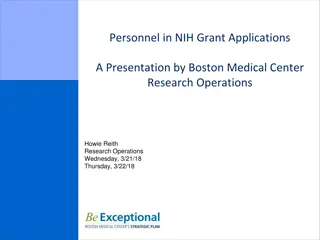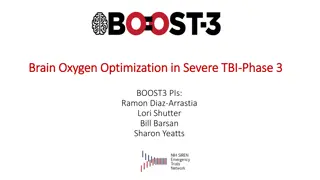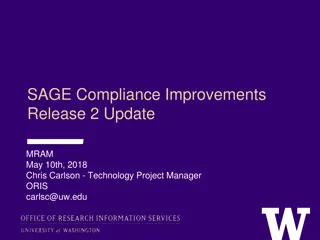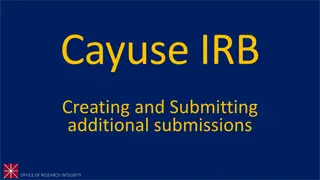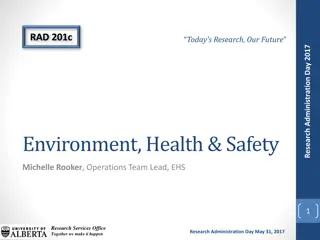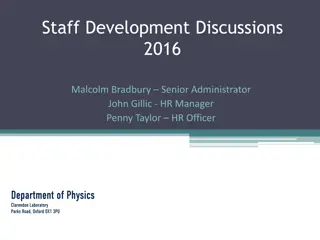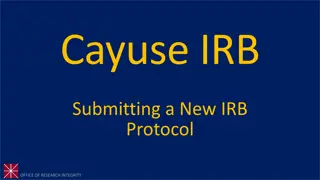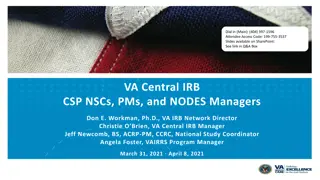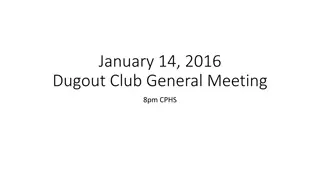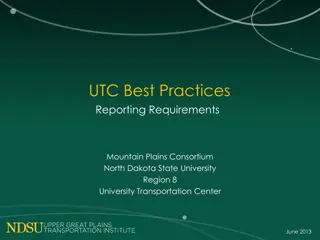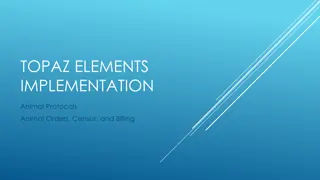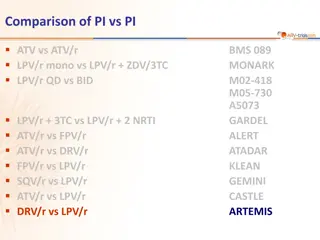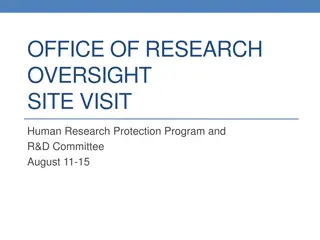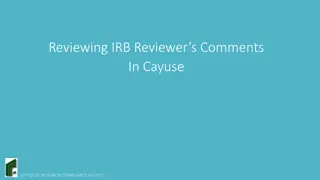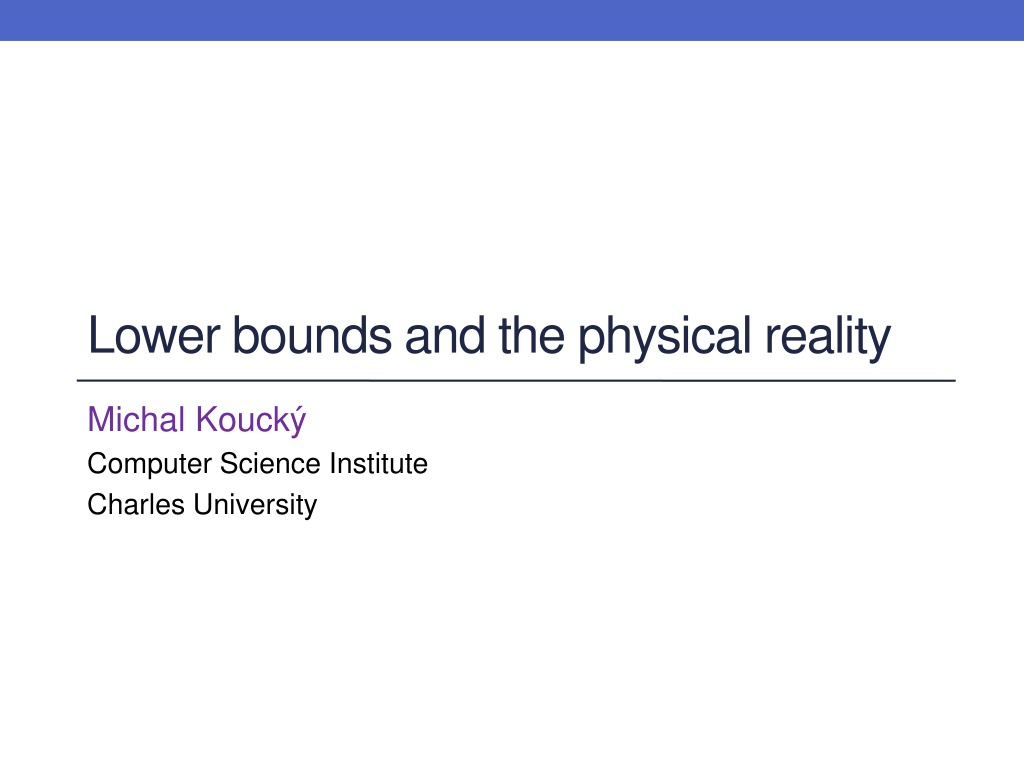
Exploring Lower Bounds in Computer Science
Delve into the realm of computer science lower bounds, focusing on topics such as P vs. NP, Boolean satisfiability, algorithm complexities, and the significance of best algorithms in problem-solving. Discover the challenging questions and implications related to solving complex computational problems efficiently.
Download Presentation

Please find below an Image/Link to download the presentation.
The content on the website is provided AS IS for your information and personal use only. It may not be sold, licensed, or shared on other websites without obtaining consent from the author. If you encounter any issues during the download, it is possible that the publisher has removed the file from their server.
You are allowed to download the files provided on this website for personal or commercial use, subject to the condition that they are used lawfully. All files are the property of their respective owners.
The content on the website is provided AS IS for your information and personal use only. It may not be sold, licensed, or shared on other websites without obtaining consent from the author.
E N D
Presentation Transcript
Lower bounds and the physical reality Michal Kouck Computer Science Institute Charles University
P = NP? Millennium Problem Clay Mathematics Institute
Satisfiability (SAT) Variables: Clauses: ?1,?2, ,?? ?2 ?17 ?25 ?31 ?37 ?27 ?17 ?23 ?51 Question: Can we set the variables to {True,False} so that all the clauses are satisfied?
Upper bound on solving SAT Algorithm for SAT: Try all possible 2? assignments and see if any of them satisfies all the clauses. Running time 2?(?). The best algorithm we know of.
P=NP? Question: Can we solve SAT in polynomial time? Popular believe: No.
Lower bounds on solving SAT Want for every k>0: Any algorithm solving SAT must run in time at least ??. Our best lower bound: (?) any algorithm solving SAT must read at least its whole input
Why do we care? Best algorithm for problem XYZ Need: a) An algorithm A for XYZ. b) An argument that there is no algorithm running faster than A.
Why do we care? Cryptography Construction of pseudo-random generators derandomization Curiosity
Constraint Satisfaction Problem Variables: ?11,?12, ,??? Constraints on the variables ??1 0 0 0 ??? 0 1 1 1 0 0 0 1 1 1 1 Question: Can we set the variables so that all constraints are satisfied? 0 0 0 0 1 1 1 0 0 0 1 1 1 1 ?21 0 0 0 0 1 1 1 ?12 0 0 0 ?11 1 ?13 1 1 ?1? 1 1,1 Ex.: ? = 01,10,0 0
Optimization Question: How many constraints can be satisfied simultaneously? (Maximize) Approximately? PCP Theorem: There is an efficient algorithm that transforms a CSP instance A into B so that A can be satisfied A cannot be satisfied B can be satisfied in B at most 95% of constraints can be satisfied at once
Particle system Particle system Each particle in one of several states. 0 0 0 0 1 1 1 0 0 0 0 0 1 1 Each particle is trying to satisfy as many constraints as it can. 0 0 0 0 1 1 1 0 0 0 0 1 1 1 Energy of the system the number of violated constraints. 0 0 0 0 0 1 1 0 0 0 0 1 1 1
Particle system Particle system In equilibrium the probability of a system being in the given state is inverse proportional to the energy (and proportional to the temperature). 0 0 0 0 1 1 1 0 0 0 0 0 1 1 0 0 0 0 1 1 1 0 0 0 0 1 1 1 0 0 0 0 0 1 1 System wants to achieve the state with the minimum energy. 0 0 0 0 1 1 1
Particle system Particle system The system cannot reach its minimal energy state efficiently at room temperature unless NP P*. 0 0 0 0 1 1 1 0 0 0 0 0 1 1 0 0 0 0 1 1 1 0 0 0 0 1 1 1 0 0 0 0 0 1 1 P* BQP (Quantum P) 0 0 0 0 1 1 1
Quantum superposition Particle system 1 2 The system can be in a quantum superposition of states. 0 0 0 0 1 0 0 1 1 0 1 1 1 1 1 2 0 0 0 0 0 0 0 0 1 0 1 1 1 1 0 0 0 0 0 0 0 1 0 0 1 1 1 1 If Quantum PCP Theorem holds then there are stable entangled states at room temperature. 0 0 0 0 0 0 0 0 1 1 1 1 1 1 0 1 1 0 0 0 0 0 1 0 1 0 1 1 0 0 0 0 1 0 0 0 1 1 1 1 1 1
Complexity ZOO LOG NL P NP PH PSPACE EXP NEXP ... and many more
Graph Reachability ? ? ? Input: Graph ?, vertices ? and ?. Output: Is there a path from ? to ??
Algorithms for Graph Reachability time space DFS/BFS ?(?) ? ? Savitch s alg. ?(?log ?) ?(log2?) Barnes et al. alg. ??(1) ?(?/2log ?) Reingold s alg. ??(1) ?(log?) undirected
Challenge Design algorithm for Graph Reachability that runs in polynomial time and space: 1. ?( ?) 2. ?(log?) Part 2. implies LOG = NL. Popular believe: LOG NL.
Lower bounds We need lower bounds to understand complexity of various problems. Our best lower bounds for general algorithms: any algorithm for given problem must read at least its whole input
Lower bounds Restricted models of computation: On-line algorithms Data-stream algorithms Bounded-depth circuits Jumping Automata on Graphs Time-space trade-offs we have optimal lower bounds for various problems.
Time-space trade-off for SAT Any algorithm for SAT that uses space ?(3?) must use time at least (?1.1).
Time-space trade-off for Reachability Any algorithm for Graph Reachability that uses space ?(?/2log ?) must use super-polynomial time. holds only for algorithms implementable on Jumping Automata on Graphs.
Barriers to proving lower bounds Relativization Algebraization Natural proofs Technical obstructions Our brain The lower bounds might be false.
Typical system + Memory available to a given process
Abstraction ? ? Input R/O ?(?) ?(?) work space R/W auxiliary space R/W Question: Is the auxiliary space useful for some computation?
Conditions on using the aux. space ? ? ? ? ? ? work space auxiliary space The content of the auxiliary space must be restored by the end of computation.
Is the auxiliary space useful? ? ? work space auxiliary space Possible use ? is compressible: compress ?, do complex computation, decompress ?. ?is incompressible: use ? as a random string for randomized log-space computation.
Conditions on using the aux. space ? ? ? ? ? ? work space auxiliary space The content of the auxiliary space must be restored by the end of computation.
Ordinary computation 0 1 t s 0 q Two different configurations can lead to the same configuration.
Reversible computation 1 s 0 q For each configuration at most one previous configuration.
Reversible computation Every step can be reversed. In principle, reversible computation requires less energy than irreversible. Erasing information always leads to dissipation of heat. E.g., operations of quantum computers are reversible (except for measurements). Studied already in 60- 70.
Reversible computation [Bennet 1973]: Every computation can be simulated reversibly. However, typical simulations require extra space to record history or time.
Algebraic approach Register machine Input registers: ?1,?2, ,?? Work registers: ?1,?2, ,?? Straight-line program (no GO-TO): ?1 ?1 + ?2 ?7 ?2 ?2 ?7 ?11 ?1 ?1 + ?2 10 ?1 ?1 ?2 10 ?2 ?2 + ?7 ?11 ?1 ?1 ?2 ?7
Ben-Or & Cleve 1989 Straight-line programs can simulate formula over arbitrary ring ?(+, ) using three registers. + + + ?2 ?1 ?1+ ?(?1, ,??) ?7 ?1 ?1 ?7?3 + ?8 ?1 formula of size ? program of size ?2
Simulation of register machine We can simulate register program using auxiliary memory. ?1 ?1 ?2 ?? copy P ? ? ? ?1+ ? subtract P 1 ? ?1 ?2 ?? work space auxiliary space
Algorithm for Graph Reachability ?(?2) ?(log?) work space auxiliary space work space auxiliary space time ?(log?) ?(?2) ?(?6) Similar algorithms also for solving linear equations,
How powerful is the auxiliary space? It could be that work space ??(1) (PSPACE) can be simulated by ?(log?) work space with ??(1) auxiliary space. However, this is unlikely as ?(log?) work space with ??(1) auxiliary space can be simulated by zero-error probabilistic algorithms (ZPP).
Acknowledgements H. Buhrman, R. Cleve, M. Kouck , B. Loff, F. Speelman. Computing with a full memory: Catalytic space. STOC'14, pp. 857-866, 2014. H. Buhrman, M. Kouck , B. Loff, F. Speelman. Catalytic Space: Non- determinism and Hierarchy. STACS, 2016, to appear. V. Girard, M. Kouck , P. McKenzie. Nonuniform catalytic space and the direct sum for space. ECCC Tech Rep. TR15-138, 2015.
Ben-Or & Cleve Formula of depth d program with 4d instructions 1. r1 r1 + r2 * f(x) 2. r1 r1 + r2 * g(x) r1 r1 + r2 * (f + g)(x) 1. r3 r3 + r2 * f(x) 2. r1 r1 + r3 * g(x) 3. r3 r3 r2 * f(x) 4. r1 r1 r3 * g(x) r1 r1 + r2 * (f * g)(x)
Catalytic computation DSPACE(S) functions computable using O(S) work space CSPACE(S) functions computable using O(S) work space and 2O(S) catalyst space. Clearly: DSPACE(S) CSPACE(S). Question: CSPACE(S) DSPACE(S)?
Catalytic computation DSPACE(S) functions computable using O(S) work space CSPACE(S) functions computable using O(S) work space and 2O(S) catalyst space. Clearly: DSPACE(S) CSPACE(S). Question: CSPACE(S) DSPACE(S)?
Power of catalytic computation LOG = DSPACE(log n) NLOG = NSPACE(log n) CLOG = CSPACE(log n) deterministic log-space non-deterministic log-space catalytic log-space Thm: LOG NLOG LOGCFL CLOG. CLOG can compute: Determinant over Z Product of nnxn matrices over Z Functions computable by log-depth threshold circuits (TC1) Functions computable by polynomial-size arithmetic circuits of polynomial degree over Z (Valiant s P)
Reversible computation Bennet 80 s: Any computation can be simulated reversibly. space S and time T space S log T and time T 1+ irreversible reversible Approach: Record history of actions taken by the Turing machine on an extra history tape. XOR the description of actions with the content of the history tape. Disadvantage: History tape has to be set to all zero at the beginning.
Reversible computation Lange-McKenzie-Tapp 90 s: Any computation can be simulated reversibly. space S and time T space S and time 2T irreversible reversible Approach: Traverse reversibly the configuration graph. Disadvantage: Takes long time. Requires clock to revert to the initial state.
Reversible circuits Toffoli gate a b c (a & b) b=1, c=1 NOT c=0 AND a b c Can simulate arbitrary Boolean circuits. Disadvantage: Needs a particular setting of auxiliary bits.
Branching programs, straight-line programs Barrington 88: Permutation branching programs of width five can evaluate Boolean formula. Ben-Or & Cleve 89: Straight-line programs with three registers can evaluate formula over arbitrary ring R(+, ). Program using instructions of the form: + + ri ri + rj * xk + x2 x7 x1 x1 x7x3 or + x8 x1 ri ri rj * xk
Transparent computation Straight-line program on a register machine Input registers: x1, x2, , xn Working registers: r1, r2, , rm Instructions: ri ri u * v u, v {x1, , xn, r1, , rm} Def: Program P computes a function f transparently if it causes: r1 r1 + f(x1, x2, , xn) regardless of the initial values of working registers r1, , rm.
Transparent computation Ben-Or & Cleve: Formulas can be computed transparently. Thm: Functions in TC1 can be computed transparently over Zp. Thm: Functions that have polynomial-size arithmetic circuits of polynomial degree can be computed transparently (Valiant s P). Question: Can x2n be computed transparently?
Back to catalytic computation We can simulate transparent program using catalytic memory. r1 r1 r2 rm copy P f r1+f ? ? substract P 1 f r1 r2 rm working tape auxiliary tape
Power of catalytic computation CLOG can compute: Determinant over Z Product of nnxn matrices over Z Functions computable by log-depth threshold circuits (TC1) Functions computable by polynomial-size arithmetic circuits of polynomial degree over Z (Valiant s P)

